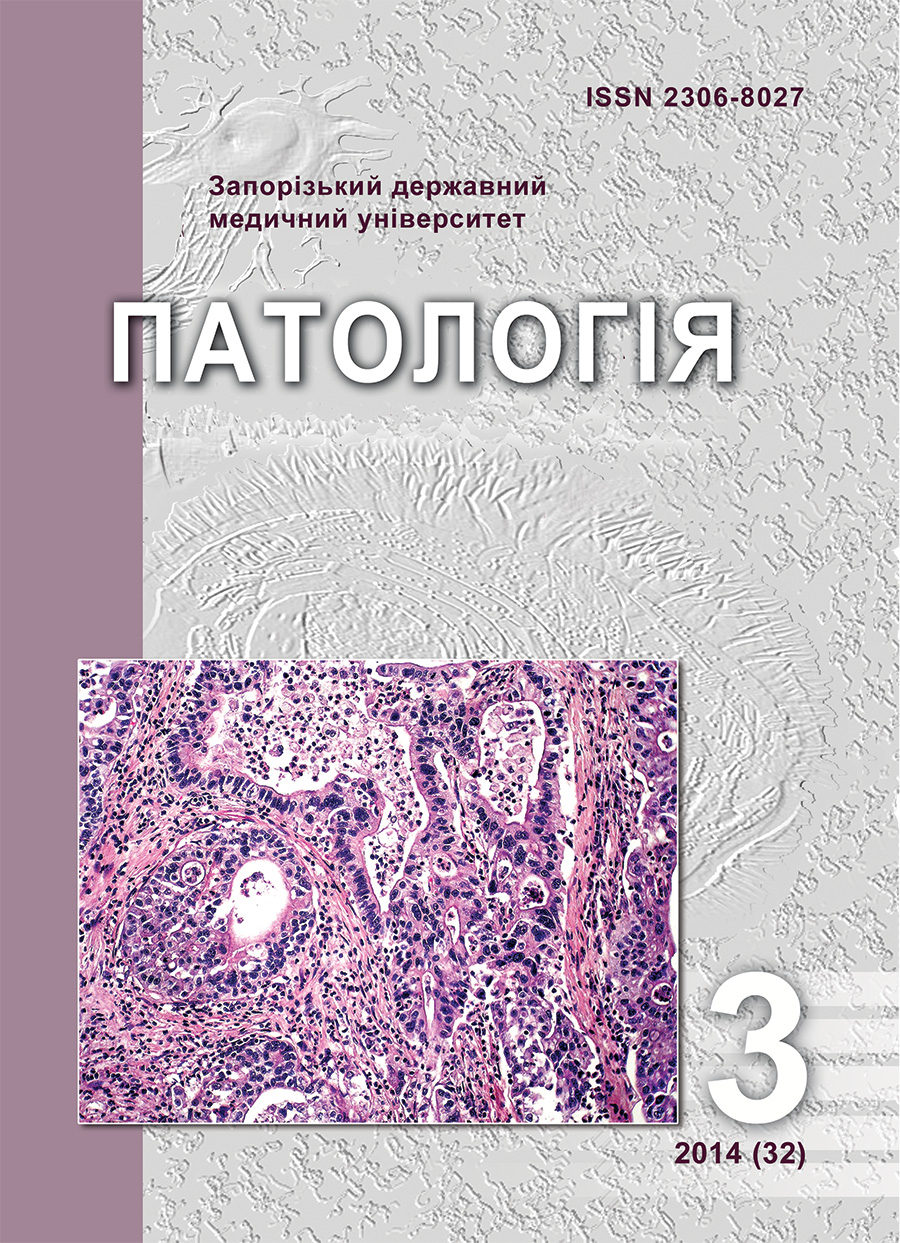Analysis of advanced non-small cell lung cancer course during high dose antiestrogen therapy use in complex chemoradiotherapy treatment of patients
DOI:
https://doi.org/10.14739/2310-1237.2014.3.37046Keywords:
Lung Neoplasms, Tamoxifen, Estrogen Receptor ModulatorsAbstract
Aim. To analyze the advanced non-small cell lung cancer course during high dose antiestrogen therapy use in complex chemoradiotherapy treatment of patients.
Methods and results. With the help of immunohistochemcial method the low expression of estrogen α and progesteron (1.7%) receptors but rather high expression of estrogen β receptors (50.8%) were established. Separation of patients into the groups with the presence or absence of estrogen β receptors allowed to show in clinical terms different mechanisms of action and the possibility of antiestrogen therapy use in the treatment of advanced non-small cell lung cancer.
Conclusion. Effectiveness of treatment and overall survival were shown to be statistically better in patients who received high doses of tamoxifen in addition to standard treatment regimens (one-year and median survival – 48.9% and 12 months, respectively) than in patients who received only standard conservative anticancer treatment (one-year and median survival – 28.2% and 9 months, respectively), which was caused by the antiestrogenic effect of tamoxifen and its non-hormonal mechanisms of antitumor action.
References
Chernykh, А. V. (2009). Sovremennye varianty leсрeniya nemelkokletochnogo raka legkogo [Contemporary variants of treatment of non-small cell lung carcinoma]. Vestnik Sankt-Peterburgskogo universiteta, 2, 150–16. [in Russian].
Davydov, M. I., Bogush, T. A., Polockij, B. E., & Tyulyandin, S. A. (2012). E`strogenovye receptory beta – novaya mishen' v terapii nemelkokletochnogo raka legkogo [Estrogen beta receptors – new target in non-small cell lung cancer treatment]. Vestnik Rossijskoj akademii medicinskikh nauk, 2, 16–22. [in Russian].
Baik, C. S., & Eaton, K. D. (2012). Estrogen Signaling in Lung Cancer. An Opportunity for Novel Therapy. Cancers, 4, 969–988. doi: 10.3390/cancers4040969.
Chen, Y. M., Perng, R. P., & Yang, K. Y. (2000). Combination chemotherapy with tamoxifen, ifosfamide, epirubicin and cisplatin in extensive-disease small-cell lung cancer. Chung Hua I Hsueh Tsa Chih (Taipei), 63, 605–611.
Perez, E. A., Gandara, D. R., & Edelman, M.J. (2003). Phase I trial of high-dose tamoxifen in combination with cisplatin in patients with lung cancer and other advanced malignancies. Cancer Invest., 21(1), 1–6.
Di Nunno, L., Larsson, L. G., & Rinehart, J. J. (2000). Estrogen and progesterone receptors in non–small cell lung cancer in 248 consecutive patients who underwent surgical resection. Archives of Pathology and Laboratory Medicine, 124(10), 1467–1470. doi: 10.1043/0003-9985(2000)124<1467:EAPRIN>2.0.CO;2.
Stabile, L. P., Dacic, S., Stabile, L. P., & Siegfried, J. M. (2011). Combined analysis of estrogen receptor β-1 and progesterone receptor expression identifies lung cancer patients with poor outcome. Clin. Cancer Res., 17(1), 154–164. doi: 10.1158/1078-0432.CCR-10-0992.
Liu, Z., Shi, H. Y., & Nawaz, Z. (2009). Tamoxifen induces the expression of maspin through estrogen receptor-N1. Cancer Lett., 209, 55–65.
Philip, P. A., & Harris, A. L. (1995). Potential for protein kinase C inhibitors. Concept mechanisms, and new targets for chemotherapy. Boston.
McClay, E. F., Albright, K. D., Jones, J. A., Christen, R. D. & Howell, S. B. (2010). Tamoxifen modulation of cisplatin cytotoxicity in human malignancies. International Journal of Cancer, 55, 1018–1022. doi: 10.1002/ijc.2910550623.
Downloads
How to Cite
Issue
Section
License
Authors who publish with this journal agree to the following terms:
Authors retain copyright and grant the journal right of first publication with the work simultaneously licensed under a Creative Commons Attribution License that allows others to share the work with an acknowledgement of the work's authorship and initial publication in this journal.

Authors are able to enter into separate, additional contractual arrangements for the non-exclusive distribution of the journal's published version of the work (e.g., post it to an institutional repository or publish it in a book), with an acknowledgement of its initial publication in this journal.
Authors are permitted and encouraged to post their work online (e.g., in institutional repositories or on their website) prior to and during the submission process, as it can lead to productive exchanges, as well as earlier and greater citation of published work (SeeThe Effect of Open Access).

